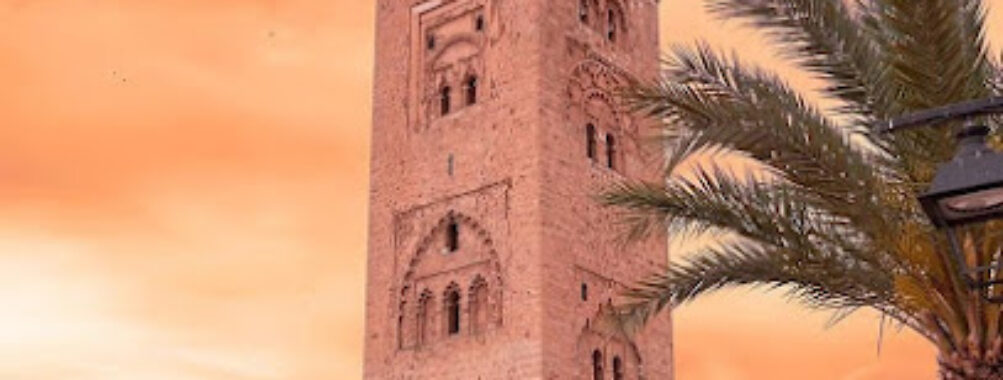
Koutoubia
Table of Contents
Description
The Koutoubia in Marrakesh is one of those places that doesn’t just stand tall, it almost feels like it watches over the whole city. Built in the 12th century during the Almohad dynasty, the mosque is a masterpiece of Islamic architecture, with its sandstone walls glowing warmly in the Moroccan sun. Its minaret, rising about 77 meters, is visible from nearly every corner of the old city, and honestly, it’s hard not to use it as your personal compass when wandering through the medina’s maze-like alleys. Some visitors are blown away by its grandeur, while others find it impressive but not necessarily life-changing. That’s kind of the beauty of it—depending on your mood, the Koutoubia can feel like a spiritual anchor, a historical marvel, or simply a peaceful backdrop for a stroll.
The mosque itself is still an active place of worship, so non-Muslim visitors can’t go inside, but the surrounding gardens and plaza are open to all. And those gardens are worth lingering in. There’s a fountain, plenty of shady spots, and benches where locals sit chatting or reading. You’ll also find families gathering in the evenings, and travelers like me taking a breather after hours of exploring. It’s a mix of calm and community, and you’ll feel it the moment you step into the space.
Accessibility is decent compared to many historic sites in Morocco. The entrance and parking area are wheelchair-friendly, and there are restrooms nearby. Still, expect some uneven ground here and there—it is centuries old, after all. Whether you’re into architecture, history, or just want a quiet spot to take in Marrakesh’s rhythm, the Koutoubia is one of those landmarks that earns its reputation. It’s not flashy, but it has presence, and that’s sometimes more powerful than anything else.
Key Features
- 12th-century mosque built under the Almohad dynasty
- A 77-meter-high minaret, one of the tallest in Marrakesh
- Distinctive Almohad architectural style with sandstone walls and intricate details
- Surrounding plaza with gardens, palm trees, and a fountain
- Wheelchair accessible entrance and parking
- Restrooms available on-site
- Still functions as an active mosque, though entry is restricted to worshippers
Best Time to Visit
If you’re wondering when to go, late afternoon is magical. The sun hits the minaret in a way that makes the stone glow, and the call to prayer echoes through the city—it’s goosebump-inducing even if you’re not religious. Early mornings are also great if you prefer quiet, since the plaza tends to fill up later in the day with both locals and tourists. Summers in Marrakesh can be brutally hot, so spring and autumn are more comfortable for walking around, especially if you want to combine your visit with exploring Jemaa el-Fnaa, which is just a short walk away. Winter has its own charm too: cooler air, fewer crowds, and a softer light that makes photos look almost cinematic.
How to Get There
The Koutoubia is right in the heart of Marrakesh, so getting there is straightforward. If you’re staying near Jemaa el-Fnaa, you can just walk—it’s maybe five minutes on foot. Taxis are plentiful, though you’ll want to agree on a price before hopping in, as meters aren’t always used. Horse-drawn carriages also pass by here, and while they’re more of a touristy option, they can be fun if you’re in the mood for something different. Personally, I loved approaching the mosque on foot from the medina; the minaret slowly comes into view above the rooftops, and it feels like you’re walking toward history itself.
Tips for Visiting
Here’s the thing: the Koutoubia isn’t about rushing in and ticking it off your list. It rewards those who slow down. So, give yourself time to sit in the gardens and watch daily life unfold around you. Bring a bottle of water, especially if you’re visiting in warmer months, because shade is limited in some spots. If you’re into photography, go at golden hour when the light softens—it makes the minaret look almost otherworldly.
Respect is key here. Since it’s an active mosque, dress modestly and avoid pointing your camera directly at people coming in to pray. And don’t be surprised if you see locals giving you a smile or even striking up a conversation. Marrakesh has a way of mixing travelers and residents in the most natural way, and the Koutoubia is a perfect example of that. Oh, and one last personal tip: bring a small notebook. Sitting in the gardens with the sound of the call to prayer in the background is the kind of moment that makes you want to jot down your thoughts, even if you’re not usually the journaling type.
Location
Places to Stay Near Koutoubia
Find and Book a Tour
Explore More Travel Guides
No reviews found! Be the first to review!